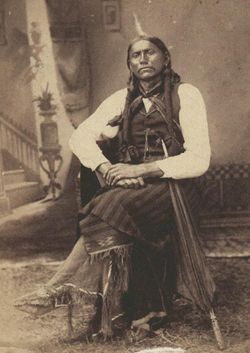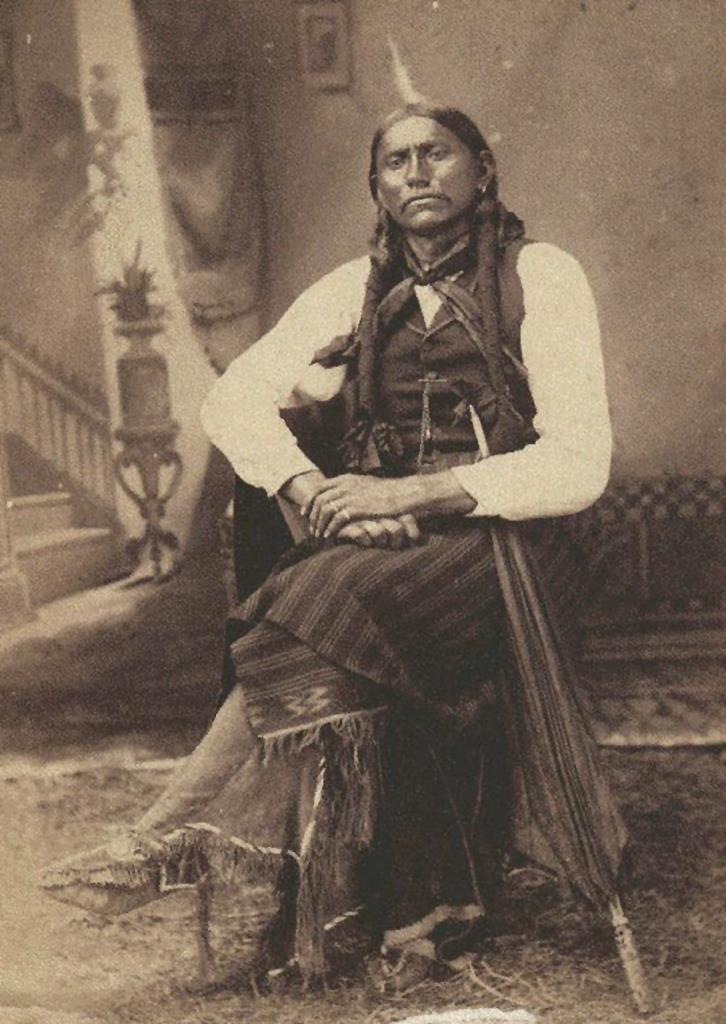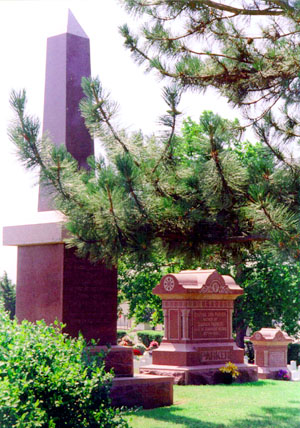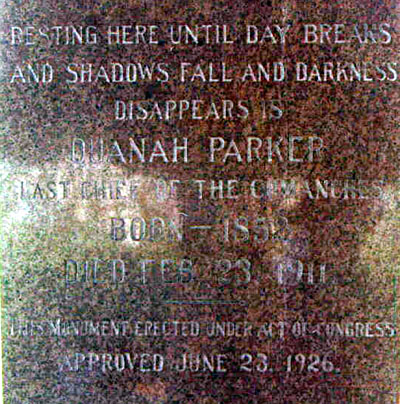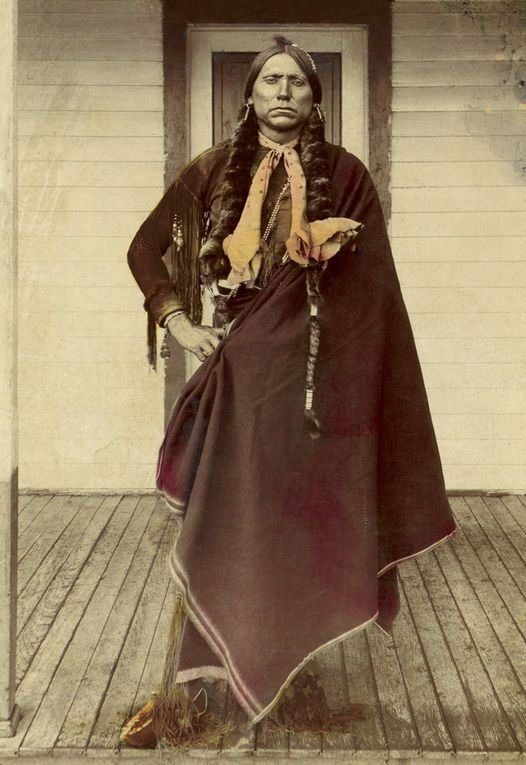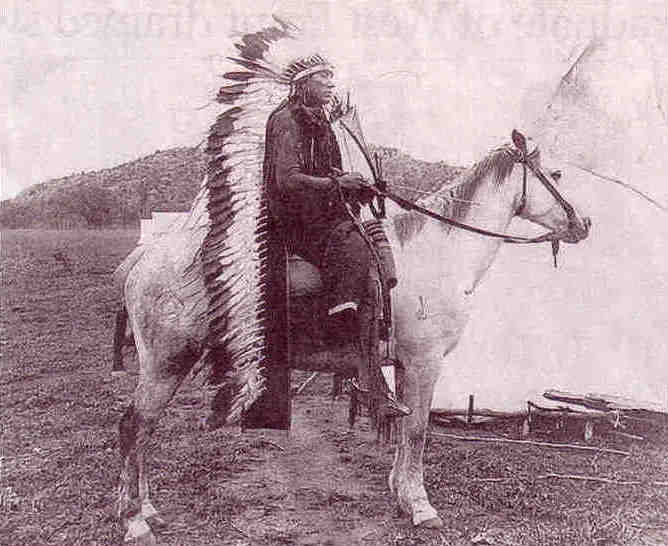Folk Figure. He is often referred to as the last Chief of the Comanches, but the truth of the matter is that the Comanche people never elected him chief. In fact, there was no such thing as Chief of the Comanches; each band of Comanches had their own chief. After the surrender of the Comanche people and their placement on the reservation, Colonel Ranald S. Mackenzie appointed him Chief of Comanches. He was the son of Peta Nacona, a noted Comanche chief, and Cynthia Ann Parker, a white woman captured by the Comanches. Quanah refused to sign the Medicine Lodge Treaty of 1867 and went on a savage eight year war against the whites. It has been said that he never lost a battle during those years.
In 1874, he had his closest brush with death when he was shot twice by buffalo hunters in a battle at Adobe Walls.
In 1875 it became very clear to Quanah that the white settlers were far too numerous and too well armed to be defeated. Mackenzie sent Jacob J. Sturm, a physician and post interpreter, to solicit Quanah's surrender. Sturm found Quanah, whom he called "a young man of much influence with his people," and pleaded his case. Quanah rode to a mesa, where he saw a wolf come toward him, howl and trot away to the northeast. Overhead, an eagle "glided lazily and then whipped his wings in the direction of Fort Sill." This was a sign, Quanah thought, and on June 2, 1875, he and his band surrendered at Fort Sill in present-day Oklahoma. The Comanches were sent to a reservation in southwestern Oklahoma. The reservation agents saw it as their duty to eliminate all tribal cultures and replace them with the ways of the white man. Quanah refused to give up his multiple wives or to cease the use of peyote. He negotiated grazing rights with Texas cattlemen, and he invested in railroads. After his appointment as chief, the older chiefs resented his youth and particularly resented his white blood.
In 1887, Yellow Bear and Chief Quanah Parker, went to Ft. Worth, Texas to discuss overdue money from leased tribal reservation lands. The two of them checked into the most modern hotel in the city, the Hotel Pickwick. Yellow Bear decided to retire early, but Quanah went with a friend for a social visit. Two hours later, Quanah returned to the hotel room, and retired for the evening. In turning off the gaslight, it is speculated either he blew the light out, not realizing the consequences, or he did not turn the valve completely off. Whatever the reason, he awoke sometime later, roused Yellow Bear, and both struggled across the floor, Quanah falling near a window, but both lost consciousness. Almost 13 hours later, the scene was discovered, and Yellow Bear was dead, and Quanah survived.
When he signed the Jerome Agreement in 1892, the tribe was split into two factions; those who thought all that could be done had been done; and those who blamed Parker for selling out. He invested wisely, owned a large home in Cache, Oklahoma, known as the Star House. He had five wives and twenty-five children. He was the wealthiest Indian in the United States. He was highly respected and hunted with Theodore Roosevelt. When he died in 1911, he was buried next to his mother and sister in the Post Oak Cemetery in Oklahoma. In 1957, all three bodies were relocated to the Chief's Knoll in the Fort Sill Cemetery, in Lawton, Oklahoma.
Folk Figure. He is often referred to as the last Chief of the Comanches, but the truth of the matter is that the Comanche people never elected him chief. In fact, there was no such thing as Chief of the Comanches; each band of Comanches had their own chief. After the surrender of the Comanche people and their placement on the reservation, Colonel Ranald S. Mackenzie appointed him Chief of Comanches. He was the son of Peta Nacona, a noted Comanche chief, and Cynthia Ann Parker, a white woman captured by the Comanches. Quanah refused to sign the Medicine Lodge Treaty of 1867 and went on a savage eight year war against the whites. It has been said that he never lost a battle during those years.
In 1874, he had his closest brush with death when he was shot twice by buffalo hunters in a battle at Adobe Walls.
In 1875 it became very clear to Quanah that the white settlers were far too numerous and too well armed to be defeated. Mackenzie sent Jacob J. Sturm, a physician and post interpreter, to solicit Quanah's surrender. Sturm found Quanah, whom he called "a young man of much influence with his people," and pleaded his case. Quanah rode to a mesa, where he saw a wolf come toward him, howl and trot away to the northeast. Overhead, an eagle "glided lazily and then whipped his wings in the direction of Fort Sill." This was a sign, Quanah thought, and on June 2, 1875, he and his band surrendered at Fort Sill in present-day Oklahoma. The Comanches were sent to a reservation in southwestern Oklahoma. The reservation agents saw it as their duty to eliminate all tribal cultures and replace them with the ways of the white man. Quanah refused to give up his multiple wives or to cease the use of peyote. He negotiated grazing rights with Texas cattlemen, and he invested in railroads. After his appointment as chief, the older chiefs resented his youth and particularly resented his white blood.
In 1887, Yellow Bear and Chief Quanah Parker, went to Ft. Worth, Texas to discuss overdue money from leased tribal reservation lands. The two of them checked into the most modern hotel in the city, the Hotel Pickwick. Yellow Bear decided to retire early, but Quanah went with a friend for a social visit. Two hours later, Quanah returned to the hotel room, and retired for the evening. In turning off the gaslight, it is speculated either he blew the light out, not realizing the consequences, or he did not turn the valve completely off. Whatever the reason, he awoke sometime later, roused Yellow Bear, and both struggled across the floor, Quanah falling near a window, but both lost consciousness. Almost 13 hours later, the scene was discovered, and Yellow Bear was dead, and Quanah survived.
When he signed the Jerome Agreement in 1892, the tribe was split into two factions; those who thought all that could be done had been done; and those who blamed Parker for selling out. He invested wisely, owned a large home in Cache, Oklahoma, known as the Star House. He had five wives and twenty-five children. He was the wealthiest Indian in the United States. He was highly respected and hunted with Theodore Roosevelt. When he died in 1911, he was buried next to his mother and sister in the Post Oak Cemetery in Oklahoma. In 1957, all three bodies were relocated to the Chief's Knoll in the Fort Sill Cemetery, in Lawton, Oklahoma.
Bio by: Tom Todd
Family Members
-
![]()
Sarah Elizabeth "Sallie" Parker Hardin
1861–1930
-
![]()
Cynthia Ann "Naunocca" Parker Cox
1873–1946
-
![]()
Laura Neda Parker Birdsong
1877–1968
-
![]()
Weyodee "Wer-Yoh-Ti" Parker Tahmahkera
1880–1965
-
![]()
Honnie "Honey" Parker
1882–1919
-
![]()
Wanada "Woon-ardy" Parker Page
1882–1970
-
![]()
Harold "Pah-ko" Parker
1883–1902
-
![]()
Esther Parker Tabbyyetchy
1887–1919
-
![]()
John Henry "Johnnie" Parker
1887–1922
-
![]()
Rev White Parker
1887–1956
-
![]()
Baldwin Parker Sr
1887–1963
-
![]()
Len "Nehio" Parker
1888–1960
-
![]()
Thomas "Tit-Tah" Parker
1889–1975
-
![]()
Mary Pache Parker Clark
1890–1952
-
![]()
Bessie Parker Asenap
1894–1927
-
![]()
Alice "Topeseup" Parker Purdy
1894–1971
-
![]()
Kelsey Topay Parker
1899–1921
-
![]()
Goverson Parker
1904–1906
-
![]()
Chee Parker
1908–1916
-
![]()
Lena Parker
Advertisement
